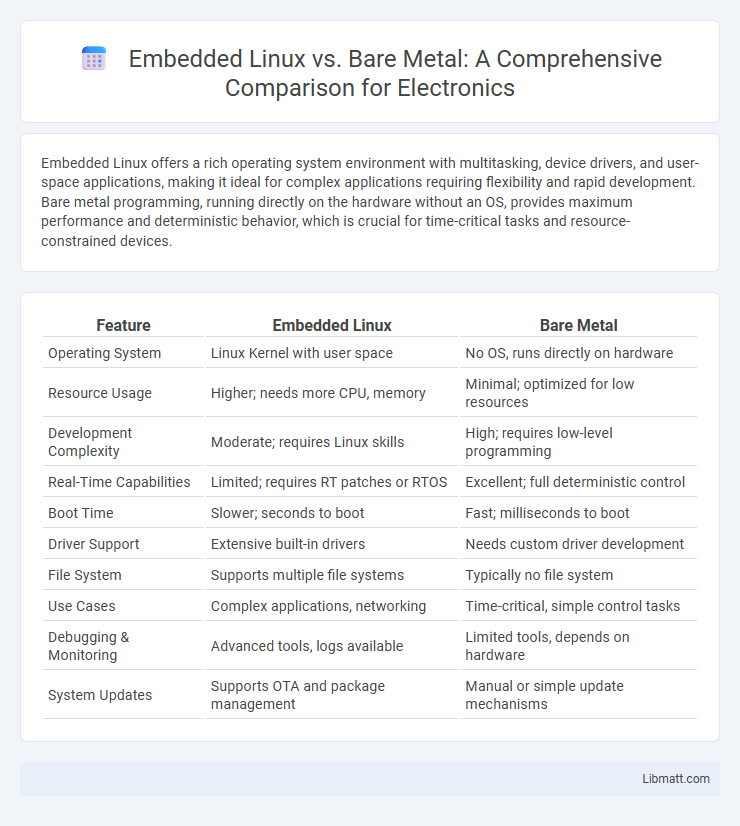Embedded Linux offers a rich operating system environment with multitasking, device drivers, and user-space applications, making it ideal for complex applications requiring flexibility and rapid development. Bare metal programming, running directly on the hardware without an OS, provides maximum performance and deterministic behavior, which is crucial for time-critical tasks and resource-constrained devices.
Table of Comparison
| Feature | Embedded Linux | Bare Metal |
|---|---|---|
| Operating System | Linux Kernel with user space | No OS, runs directly on hardware |
| Resource Usage | Higher; needs more CPU, memory | Minimal; optimized for low resources |
| Development Complexity | Moderate; requires Linux skills | High; requires low-level programming |
| Real-Time Capabilities | Limited; requires RT patches or RTOS | Excellent; full deterministic control |
| Boot Time | Slower; seconds to boot | Fast; milliseconds to boot |
| Driver Support | Extensive built-in drivers | Needs custom driver development |
| File System | Supports multiple file systems | Typically no file system |
| Use Cases | Complex applications, networking | Time-critical, simple control tasks |
| Debugging & Monitoring | Advanced tools, logs available | Limited tools, depends on hardware |
| System Updates | Supports OTA and package management | Manual or simple update mechanisms |
Introduction to Embedded Linux and Bare Metal
Embedded Linux is an operating system tailored for embedded devices, offering robust multitasking, networking, and hardware abstraction capabilities critical for complex applications. Bare metal programming involves running software directly on hardware without an operating system, providing maximum control, minimal latency, and predictable timing essential for real-time and resource-constrained environments. Choosing between Embedded Linux and bare metal depends on the specific application requirements, including system complexity, hardware resources, and development time constraints.
Key Differences Between Embedded Linux and Bare Metal
Embedded Linux offers a full operating system with multitasking, networking, and file system support, while bare metal programming runs directly on hardware without an OS, providing minimal latency and maximum control. Embedded Linux requires more memory and processing power compared to bare metal, which is ideal for low-resource environments. Your choice depends on application complexity, real-time requirements, and available hardware resources.
System Architecture Overview
Embedded Linux features a layered system architecture comprising a bootloader, Linux kernel, middleware, and user-space applications, enabling multitasking and rich peripheral support. Bare metal systems operate directly on the hardware without an operating system, typically utilizing a single-threaded loop or simple scheduler for task management. The complexity of Embedded Linux allows for scalability and extensive device drivers, whereas bare metal offers minimal latency and maximum control over hardware resources.
Performance Considerations
Bare metal systems offer superior performance by running code directly on hardware without an operating system, minimizing latency and maximizing resource utilization. Embedded Linux introduces overhead due to kernel operations and process management, which can impact real-time responsiveness but provides better multitasking and hardware abstraction. Performance-critical applications often prefer bare metal for deterministic behavior, while Embedded Linux suits complex tasks requiring scalability and device support.
Real-Time Capabilities
Embedded Linux offers robust real-time capabilities through real-time patches and PREEMPT-RT extensions, enabling deterministic task scheduling and low-latency interrupts suitable for complex applications requiring multitasking and network connectivity. Bare metal systems, by running without an operating system, provide superior real-time performance with minimal interrupt latency and maximum control over hardware, ideal for time-critical applications with stringent timing requirements. Your choice depends on the balance between system complexity, real-time precision, and the need for additional features like networking and file systems.
Memory and Resource Requirements
Embedded Linux demands more memory and system resources compared to bare metal due to its operating system kernel, libraries, and services, typically requiring several megabytes of RAM and flash storage. Bare metal systems operate directly on hardware with minimal overhead, often fitting into kilobytes of memory and enabling faster boot times and lower latency. Choosing between Embedded Linux and bare metal hinges on balancing resource availability with the need for complex features and multitasking support.
Development Complexity and Toolchains
Embedded Linux development involves a higher complexity due to its extensive feature set, multitasking capabilities, and the need for comprehensive toolchains including cross-compilers, debuggers, and build systems like Yocto or Buildroot. Bare metal programming offers a simpler development environment with direct hardware access, minimal runtime overhead, and typically uses basic toolchains such as ARM GCC or MPLAB for microcontrollers. Choosing between Embedded Linux and bare metal depends on project requirements for scalability, development time, and the available ecosystem of debugging and integration tools.
Use Cases and Application Scenarios
Embedded Linux excels in complex use cases like IoT devices, industrial automation, and smart home systems due to its robust multitasking, networking, and driver support capabilities. Bare metal programming suits real-time applications, automotive control systems, and biomedical devices where minimal latency and direct hardware access are critical for performance and reliability. Your choice depends on whether your project demands a rich operating system environment or deterministic, low-level hardware control.
Security Implications
Embedded Linux offers enhanced security features such as user authentication, access controls, and regular security patches, which are critical for protecting complex systems against cyber threats. Bare metal systems, running without an operating system, have a smaller attack surface and lower overhead but lack built-in security mechanisms, placing the onus on developers to implement custom protections. Your choice between Embedded Linux and bare metal should consider the balance between security controls and system complexity based on your application's risk profile.
Choosing the Right Approach for Your Project
Selecting between Embedded Linux and Bare Metal depends on project complexity, resource availability, and real-time requirements. Embedded Linux offers extensive hardware support, multitasking, and network connectivity, making it ideal for devices needing advanced features and scalability. Bare Metal programming provides direct hardware control with minimal latency, suitable for time-critical applications with limited resources.
Embedded Linux vs Bare metal Infographic

 libmatt.com
libmatt.com